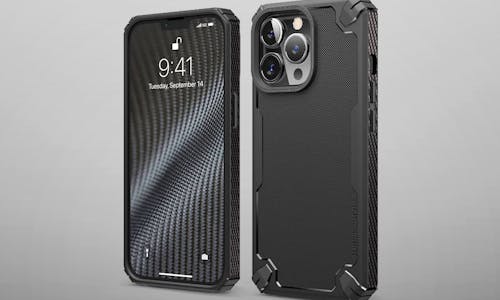Shooting great video with your mobile phone doesn’t just depend on great tech. Here are our top five tips to shoot better video with your phone camera.

Our mobile phones might shoot great video now thanks to their improved sensors, advanced image processing etc, but a great smartphone camera is only as good as the person operating it. So, here’s a few helpful hints and tips to transform you into the next mobile equivalent of Wally Pfister (lead cinematographer on Nolan’s Batman trilogy, Memento), Lubezki (Children of Men) or Gilbert Taylor (friggin’ Star Wars!).
1. Tuck your arms in and film in landscape
Let’s start with the basics. This tip comes in two parts: they say ‘two heads are better than one’ and the same goes for hands. Handling your phone with both hands will immediately improve stability and give you greater control should you want to tweak your shooting angle. By bringing your arms closer into your body and resting your elbows against your sides, you give yourself even greater stability and control.

Part two is another simple, but often forgotten element to the world of smartphone video. With the exception of mobile-to-mobile experiences like Snapchat, practically every other display we view content on is nowadays designed to be set in a landscape orientation. From your TV, to your laptop, to a cinema screen, video footage best suits landscape capture, so don’t forget to turn your phone sideways before you hit the record button.
2. Let Hyperlapse be your steadycam
Whilst our bodies are amazing things, sometimes they just don’t cut the mustard when you’re trying to capture truly stable video. Thankfully you don’t have to shell out thousands of pounds for the harness, counterweights and mechanical arm that make a real Steadicam rig; Instagram’s Hyperlapse app can lend a hand instead.
Here’s the launch video from Instagram’s blog showcasing its Hyperlapse technology:
Most top tier phones already offer inbuilt image stabilisation chops, whether that’s using a digital method (Sony Xperia Z3, iPhone 6), an optical method (Nokia Lumia 930, iPhone 6 Plus) or a combination of the two (Samsung Galaxy Note 4), but thanks to the gyroscope built into your smartphone of choice, Hyperlapse can automatically reverse much of that unintended image shake; just resist the urge to speed up your footage, which undoes all the goodness. However, remember that you lose out on audio recording with this method. (There are other third-party apps that offer similar results).
3. Film on bright, cloudy days for best results
A simple thing like lighting can really make or a break a nicely composed shot. Assuming you don’t have a set of professional lights, diffusers and reflectors, not to mention a team of people to operate them all whilst you’re capturing a Vine, you’ll have to learn how to use that glorious English weather instead.

Whilst filming on a sunny summer’s day might offer the most comfortable shooting environment, bright overcast skies are a better alternative for capturing video on your phone. Smartphones come with a relatively narrow dynamic range and whilst some are capable of filming in HDR, high contrast environments usually force your phone’s camera to adjust on the fly as you capture content that jumps from shade to bright sunlight. On a bright cloudy day, the sun’s light is diffused, softening shadows and allowing your footage to take on a more even-balanced exposure.
4. Play with frame rates
If you’re lucky enough to own a powerful smartphone with a good camera, chances are it will give you the ability to select a frame rate. Those aiming for a more dramatic finish to their footage should set their phones to a lower frame rate of around 24fps. Most movies playback at this speed and your footage will be in with a chance of adopting that same cinematic feel.

30fps is what we’ve come to expect from your garden-variety smartphone video, which is similar to live broadcast with a smoother aesthetic. Then we have 60fps. At regular playback speeds, this gives an almost unsettlingly smooth finish and affords finer detail in your shots. You can also start getting creative with slow motion, by slowing footage shot at 60fps back down to 30 or 24fps.
The same can be said for super slow motion too. Handsets like the iPhone 6 and Xperia Z3 can capture video in the 120fps to 240fps region, giving you the opportunity to add some real drama and dynamism to your cinematic masterpiece.
5. Accessorise!
Whilst the toolset of the smartphone camera has improved significantly in its own right over the last few years, that hasn’t stopped companies from other corners of the photography and cinematography world from getting involved too.
GoPro’s actions cameras can be managed in real-time and footage can be cut and uploaded directly on your smartphone, without the need for a computer. Apple’s mobile take on iMovie also turns your smartphone into a self-contained editing suite.

There are a myriad of miniature lenses built especially for mobile from esteemed photography specialists like Manfrotto and if you’ve got some serious cash to splash you can recreate Bentley’s “Intelligent Details” video. This was shot exclusively with the iPhone 5S and a mountain and specialised mounts, gimbals and lenses.
Whether you’re filming your little brother’s birthday party or creating your own spinoff sequel to Avatar, these hints and tips have hopefully given you a better understanding of how to attain serious smartphone cinematographer status with some professional looking footage.
Why not get creative with your smartphone’s camera and share the results with us via Twitter, @Recombu.

Leave a Reply